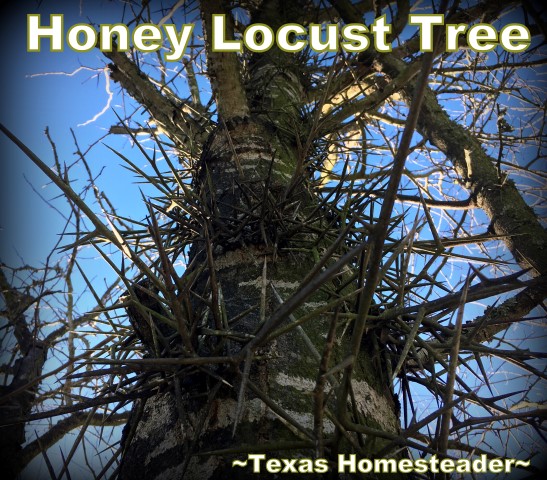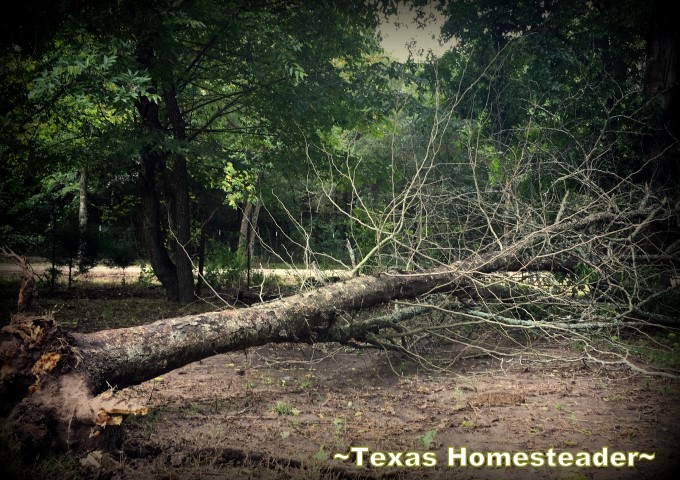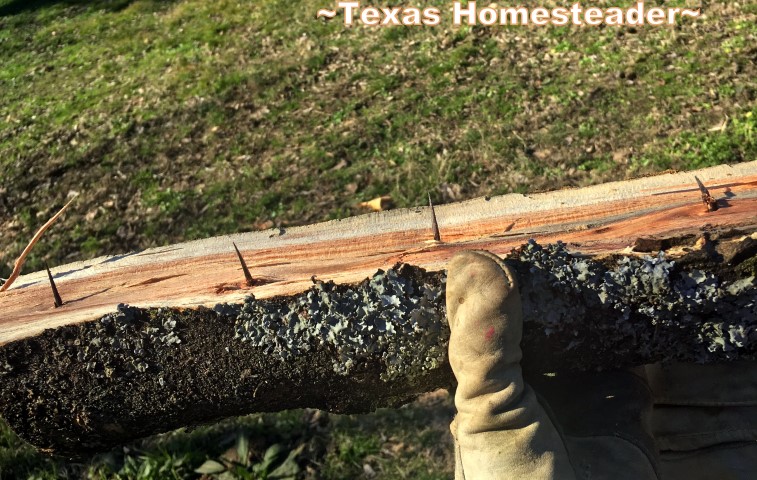~ by Texas Homesteader ~
The Honey Locust tree has a pretty name, but it’s a MEAN TREE with long thorns! They grow everywhere on our NE Texas property. For the most part we consider them troublesome and invasive. But there are some really good features too.
NE Texas Property Filled with Honey Locust Thorn Trees!
When RancherMan & I found this little piece of paradise, we were smitten that’s for sure. As we looked over that old fence at the dilapidated 1880’s barn and overgrown property, we saw something beautiful. We saw where our future would be found. We saw HOME.
It’s been lots of work getting our property where it is now, and we’re nowhere near done.
You see, there’s a prolific tree growing here called ‘Honey Locust’. For the most part we find these trees troublesome. But out of a useless tree, at least there are some useful features
Honey Locust Tree USELESS Features
-
Massive Thorns
There are LOTS of thorns on a Honey Locust tree! In the first photo above you can see this tree’s trunk is covered with an almost impenetrable mass of thorns all along the trunk and all along the branches too. And these aren’t regular sized thorns y’all. Some thorns are right at a foot long!
Those thorns are tough too. They’ll easily go through a work boot and can flatten a tractor tire in a heartbeat. We’ve had cattle that were injured after stepping on those thorns.
-
Honey Locust Trees Are Hard To Control
Want to cut them down? HOW??!! How do you get the chainsaw through the thorns to get to the trunk?
And once you do, how do you grasp the cut limb to haul it off? And do you really want to broadcast those thorns as you drag a limb away? (I’ll answer for you. No, no you do not!)
Let me tell ya, much bloodshed has happened for me and RancherMan as we vow to rid our property of each and every one of these ‘Satan Trees’!
And the female trees also produce bean pods, a favorite food for many critters.
Of course when the bean pods are eaten the seeds are deposited elsewhere in their scat. Many animals don’t digest the seeds so more trees are seeded this way. yippee…
Honey Locust Tree USEFUL Features
OK, we hate the trees y’all. It’s our fervent desire to one day rid our property of Every. Single. One. But they do have some useful features.
-
Honey Locust Flowers A Honeybee Favorite
The blossoms of the honey locust tree are favored by honeybees (and other pollinators as well).
We’re told by our beekeeper’s association that honey made from the blossoms of the honey locust is some mighty-fine honey indeed. We’re beekeepers so that certainly appeals to us.
-
Honey Locust Wood Is Good Firewood
Honey Locust wood makes pretty darn good firewood too.
According to the Forestry dept, a cord of Honey Locust is dense wood, weighing from 3800 – 4600 lbs & containing a whopping 26.7 MILLION BTU’s.
Honey Locust fares well in all the Forestry categories: Easy splitting, low smoke, few sparks, excellent coals, slight fragrance and excellent overall quality. (reference links below)
RancherMan & I recently harvested a Honey Locust that had died but remained standing. As it stood, it seasoned without rotting like it would on the ground. Then one day a heavy wind blew it down, the roots no longer able to support it.
But since it remained standing until now the wood was still in very good shape for firewood. It’s very dense and it makes a nice hot fire that lasts a long time.
So RancherMan & I started by CAREFULLY cutting away the fanning limbs (filled with thorns) to get to the trunk.
When nothing remained but the trunk I ran a sharp blade along the surface to dislodge most of the thorny masses.
When the thorns were dislodged we raked them away to keep us from stepping on them as we worked. Then RancherMan cut the trunk into firewood-log-sized chunks and we split the logs.
I was amazed to see this in a piece of split Honey Locust wood. DANG, there are even thorns INSIDE the wood!
- Honey Locust Tree Beauty
OK I’ll admit it. The tree is very pretty. Its leaves are dainty, the fall color is nice and the tree itself makes a nice shade tree too.
So although we’re still anxious to one day rid our property of the remaining thousands of Honey Locust trees, at least in the meantime they do serve some purpose.
~TxH~
NE Texas Native or Wild Trees & Plants
- Honey Locust Tree – Useless yet Useful
- Identifying A Western Soapberry Tree
- Bois d’Arc – Beautiful & Functional Tree
- Jujube Tree Produces Sweet Fruits
- Wild Plum Tree Offers Plums For Delicious Jelly
- Keeping Bermuda Grass Out Of Garden Beds
- Foraging: Eating From The Land For FREE!
- Using Nature For Beautiful Natural Tablescape
Other Tx Native Wildlife Posts
Wild Hogs
Protecting Wildlife
- Trapping & Relocating An Armadillo
- How To Safely Catch & Relocate A Beneficial Snake
- Adding Temporary Protection For Wild Rabbit’s Nest
Wild Birds
- Keeping Wild Birds From Eating Your Chicken’s Feed
- How To Keep Birds (and their POOP) Off Your Railings
Pests
See All Our Native Plants & Wildlife Posts
C’mon by & sit a spell! Come hang out at our Facebook Page. It’s like sitting in a front porch rocker with a glass of cold iced tea – lots of good folks sharing! You can also follow along on Pinterest, on Twitter or on Instagram.
If you’d like to receive an email each time a new blog post goes live it’s EASY to Subscribe to our blog!
References






Our county recently dumped a whole, dead honey locust tree in a neighbor’s field a few months ago (presently 4/16/2022). I didn’t know what the species was until now, but I was eyeing it for firewood.
Finally got around to cutting it up and I couldn’t believe how dense and hard the main trunk wood was. I thought my chainsaw blade was dull. It was a lot of work and seemed to take forever to buck up the main trunk. I cut the logs into 12 inch lengths to make them easier to handle, but I estimated they still weighed between 60-80 lbs. each, maybe more for the larger diameter chunks.
Thanks for the entertaining and informative blogpost about the honey locust tree. It was encouraging to read that we’ll have some really nice firewood once it finishes seasoning.
We were very surprised at the usefulness of these Honey Locust trees for firewood. But seasoned and split logs from the trees worked beautifully in our fireplace. ~TxH~
We have these trees here in MO. One of the most useful things not mentioned is there root system helps hold the earth in place. So while I don’t want these on any flat part of the land, on the hills where the rainstorms come with such force, the trees prevent the hillside from washing away. Second, these trees, when used for such things as fenceposts, we have been told, will last a hundred years. To cut them down, first you need to ring the tree with a chainsaw and let stand and die for a year. If you don’t wait, 50 shoots will start out of the trunk. Just a menace. If you choose chemicals, Tordan will kill off the trunk. But yes, this tree makes good firewood. We personally mix it with other wood when burning as the fire gets so hot.
We’ve read about ringing the tree and that sounds like the perfect solution to harvest them for firewood since it keeps the tree standing until dead. When we used it in the fireplace I was so pleased with the firewoodability of Honey Locust wood. LOL ~TxH~
As a fellow land owner with many of these trees we found last year the bees did like the blossoms of Spring. We plan to remove all the females that create the seed pods, use these for firewood (after many many months of aging) and keep the males around for shade and beauty. We also have found as the tree ages we can twist off the lower thorns to keep from snagging them or the little ones getting snagged by one when playing. Put in a bucket and dump in the fire pit. Great pic on the inside that is a new sight I have not seen.
The bees do love those blossoms Angela, and they make great honey. But heck they love the wild plum trees too – and those trees bloom prolifically & give me fruit! ~TxH~
Glad I don’t have these trees on my place!
They’re mean trees, that’s for sure Ken. And we’ve rid our property of thousands of them so far, with thousands remaining. Our goal is to eliminate them all, I’m just thrilled they have SOME value in the meantime.~TxH~
Wow and we have always whined about the masses of blackberry that we fight to reclaim land. I believe I have heard that Luther Burbank (of plant fame) thought that the berries were so delish (no argument there) that we should have them in the US and brought them to the US . Huge masses of very thorny (not like your locust) canes with big sweet berries great for jelly – too seedy for jam. They and English ivy (we don’t have that on our place thank heaven) are just horrible. Here’s a blurb about them from the internet:
Even the origins of Himalayan blackberry are almost mythic: In the late 1800s, botanist/entrepreneur Luther Burbank brought the plant to his California farm in the hope of selling it far and wide. Burbank was a constant experimenter; his creations include the Shasta daisy, elephant garlic, and the predecessor to the Russet potato.
I doubt anyone in their right mind would buy them!!!
LOL Candace. Those blackberry vines are pretty hard to control too. But dang I love those wild blackberries. So for the most part I turn the other cheek around them. But when they start getting out of hand you’ve gotta tackle them too. But these Honey Locusts? Man, talk about a challenge. How the heck do you even cut them down??!! One day there will not be a single one standing our our place, that’s our vow… We take down hundreds every year either mechanically, by drought or even with (gasp) poison. But some day we’ll be free to walk our land without the fear of their thorns. ~TxH~